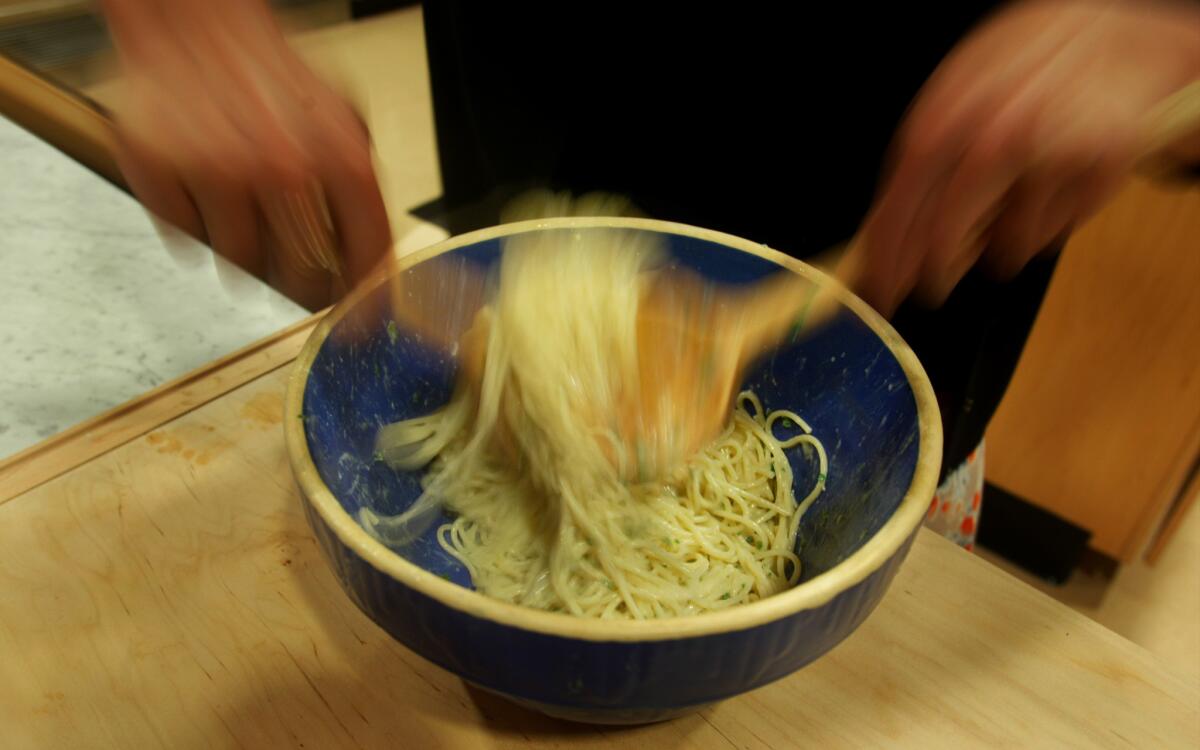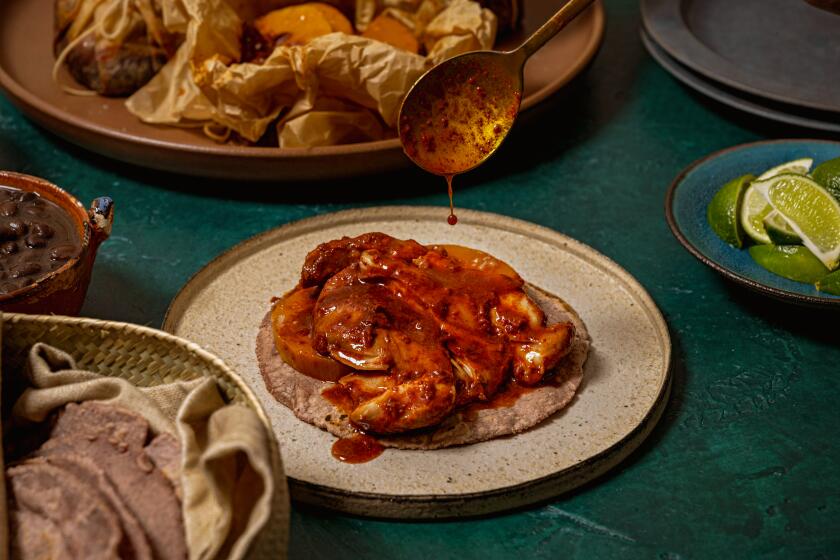Marcella Hazan's Spaghetti Carbonara

- Share via
We weren’t wrong to fall in love with spaghetti carbonara in the 1970s. We were early. We did it before we realized that Parmesan is better grated from a block of aged Parmigiano-Reggiano than shaken from a can.
And we were innocent. We couldn’t quite keep our sauces straight. Often as not, we substituted carbonara’s eggs for the cream of a fettuccine Alfredo, exchanging a supple texture for a heavy one. As for what we did to the noodles, adding oil to the cooking water, flinging partly cooked spaghetti at the wall convinced that a done strand would stick, then rinsing this flogged pasta in cold water.... Your honor, we seek the mercy of the court. We were young.
Then came Italian chemist Marcella Hazan, so beloved even strangers call her Marcella. Her meticulous series of books on Italian food, starting in the 1970s and progressing through the ‘80s and ‘90s, introduced Americans to the kind of Italian food that Italians might actually recognize. She won my heart with spaghetti carbonara. She offered a recipe radically different from the heavy, salty-sweet American standard, while raising a skeptical eyebrow over its supposed origin as a World War II dish concocted by Italians for American servicemen yearning for bacon and eggs. She describes the earthy flavor as “unmistakably Roman.”
But by the time Hazan fixed the recipe, and the right ingredients found their way into stores, America was abandoning the dish. Young cooks were too busy discovering osso buco, risotto and baby artichokes to bother with a pasta synonymous with restaurants that had canned peas on the menu and “My Way” on the jukebox.
If fashion wasn’t hard enough on spaghetti carbonara, do-gooders weighed in. Health officials began to rumble ominously about perils posed by fresh eggs, and dietitians stepped up scolding about the deleterious effects of fat and salt. Carbonara was not just out--it was, we were led to believe, out to get us.
Ah, if only a steaming plate of it would mug me this very minute. I can think of no better food. That an entire generation has missed out on the dish seems unfathomable, faintly criminal, every bit as wrong as the worst excesses inflicted on the dish by my own generation and my parents’ before Hazan came along. If any food got a bum rap, spaghetti carbonara is it. If any dish deserves rehabilitation, a glorious new vogue, this is it.
First, forget the stuff about it being heavy. It’s a light dish, light enough to have been a traditional starter. Moreover, food poisoning from the eggs is the remotest of risks, unless the cook cracks the eggs hours before making it, then leaves them sitting around.
But spaghetti carbonara isn’t a dish for newborns, convalescents or people who have a fearful relationship with food. It’s for food lovers. It’s food best eaten warm, right from the stove, in the kitchen, as dinner for two. The preparation of spaghetti carbonara could not be more congenial. It comes replete with its own dynamic, its own tantalizing tempo and heady succession of good smells.
Always start by setting out a large pot of water on the stove. It will be boiling by the time you need it. By the time the cork is squeaking in the Chianti bottle or some robust tannic red--a food wine--the air should be moist, with steam running down the windowpanes. As your guest swirls the first taste of wine, you are tossing out the garlic from the infused oil and adding the pancetta.
Your guest suddenly looks wolfish. For mercy’s sake, give the guest some olives! Better yet, hand over the watercress so the guest can pluck off the stems and drop the leaves into a bowl for quick tossing with olive oil and red wine vinegar. Served as a main course, the only thing you’ll need with spaghetti carbonara is a side dish, or palate cleanser, of a watercress salad. Arugula works too. But not lettuce. It needs to be a peppery green.
The pancetta’s ready. The parsley is chopped. You cut a slice of Parmesan for your guest to nibble, then hand him the grater, the Parmesan and the Romano. This second cheese, the slightly sharp sheep’s milk answer to Parmesan, will give the dish some piquancy.
You’ve got a steaming pot to check. You raise the lid, making sure the water level is still high. Pasta needs room to cook properly. You add a dramatic dash of salt, which causes the water to roil--you feel like a magician. It subsides, and you slip in the pasta and adjust the heat so the pot doesn’t boil over. Most important, you stir it with a long-handled spoon and set the lid at an angle for the steam to escape.
Now you crack your eggs into a serving dish--Hazan prefers a flat ceramic roasting dish to a bowl; easier to toss. You add the grated cheese, the parsley and the pepper, tell your guest a story, listen and laugh. Reheat the pancetta that you’ve deglazed with a splash of white wine. Toss back the last of your first glass of wine.
It’s time to check the pasta. Fish out a strand. Look at it. The change in color is so distinct, from wheat gold to translucent amber, you’ll always know a done noodle by its hue from this day forward.
Now comes the theater, the draining of the pasta. You give the dog a nudge--the big dope should not be napping in the path between stove and sink. As you drain the pasta, you don’t leave it to sit. You decant it quickly from the strainer to the serving tray with the eggs, and toss. The water trapped in the noodles will loosen the mix.
Just as the cheese smells rise, you add the bacon. Your guest might faint with anticipation, but because there are only two of you, in only seconds your plates are full, your wineglasses are full, you are winding the hot pasta on your forks and toasting this good life.
Bring a large pot of salted water to boil.
Meanwhile, cut the pancetta or bacon into strips not quite 1/4-inch wide.
Lightly mash the garlic with a knife handle, enough to split the cloves and loosen the skin; discard the skin. Place the garlic and olive oil in a skillet and turn the heat to medium-high. When the garlic turns a deep gold, about 2 minutes, remove it and discard.
Place the strips of pancetta or bacon in the pan and cook until they just begin to crisp at the edges, stirring often, about 5 minutes. Add the wine and let it bubble away for 1 to 2 minutes, then turn the heat off.
Add the spaghetti to the boiling water, and cook until al dente, about 8 to 10 minutes. Drain.
Break the eggs into the serving bowl in which you’ll be tossing the pasta. Beat them lightly with a fork, then add the Romano and Parmigiano-Reggiano, a liberal grinding of pepper and the chopped parsley. Mix thoroughly.
Add the spaghetti to the bowl and toss rapidly, coating the strands well. Briefly reheat the pancetta or bacon over high heat, turn the entire contents into the bowl of spaghetti and toss thoroughly again. Serve at once.
Get our Cooking newsletter
Get a taste of Los Angeles — and the world — with recipes and kitchen tricks from the L.A. Times’ Cooking newsletter.
You may occasionally receive promotional content from the Los Angeles Times.















